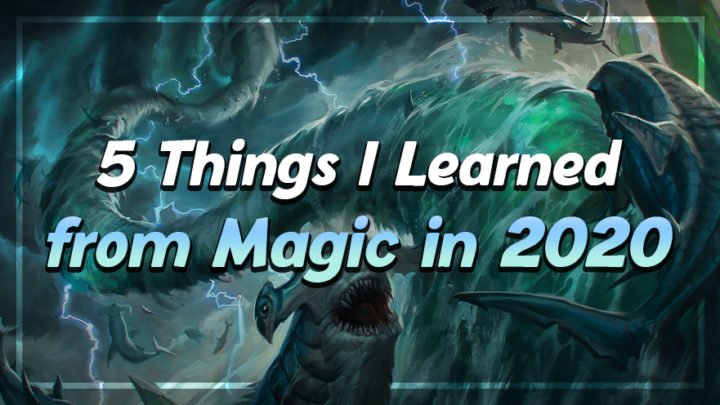The year is winding down, and the whole Magic world is waiting for Kaldheim previews to start next week. With things relatively calm before the massive storm Kaldheim is sure to bring, I thought it might be nice to take this time to reflect on the past year. While looking back, I realized that five of my favorite cards from 2020 all taught me something about the game. So today, I’m going to share those cards and what I’ve learned about Magic with you. Hopefully, the lessons I learned will give you a better understanding of and appreciation for the game.
CLING TO DUST: THE POWER OF FLEXIBILITY

Cling has quickly become one of my favorite cards in recent years. For just a single mana, you get to gain three life or draw a card. Then, in the later game, you can play it again at a much higher cost. Very simple and very elegant. Despite being so simple, it has a lot of play to it and opens the door to many exciting play moments.
I’ve written a bit about what Cling to Dust taught me in the past, but the main point is that flexibility can be worth more than power level. Sometimes, you’re looking for a scalpel instead of a chainsaw. Cards like Cling are rarely good enough to earn four main deck slots, but by having access to a couple in your deck, you can completely change the way games play out. This flexibility will allow you to leverage your skill and get out of precious situations — and all for the low cost of one mana.
Cling to Dust is rarely the sole reason you win a game — it’s certainly no Uro — but the role it plays in decks should never be taken for granted. My MO in the past was simply to play the most efficient cards possible and streamline my decks, thinking that this would yield the most success. Now, I realize that there are times and places for more versatile cards that open the door to options you wouldn’t normally have.
MAYHEM DEVIL: PLAYING DELIBERATELY

Okay, so technically, Mayhem Devil was printed in 2019, but I didn’t really start playing with it until late into 2020, when Jund Sacrifice was the best Standard deck. Since that point, Mayhem Devil and I have spent a lot of time together. Much like Cling, Devil is a simple card: whenever anything gets sacrificed, you can deal one damage to any target. But the amount of plays you can pull off with this card is astounding and mind boggling.
Once Devil hits the battlefield, the board instantly becomes more complicated. Any action could set off a chain of events that leads to multiple creatures dying or a player losing the game. Board complexity and reading has always been a strength of mine, but Mayhem Devil — and especially Mayhem Devil mirrors — makes these situations incredibly unforgiving. Mayhem Devil taught not to rest on my laurels, and more importantly, it taught me to slow down and evaluate the board carefully. I’m unsure how many wins I’ve missed because I rushed through a turn where Mayhem Devil was in play, but I assume it’s a large number.
Many players equate playing slowly with playing poorly, and I think that’s simply not true. Mayhem Devil helped me see the difference, and to actively take more pauses before executing my whole turn. While you do have more time pressure in tabletop Magic, as you and your opponent share a clock, digital Magic gives you the luxury of more time. So while we are still in this digital-only phase of competitive Magic, we should use that time to our advantage. You’re less likely to lose to the Arena clock than you are to lose a game because you rushed through a complex turn.
SHARK TYPHOON: OPPORTUNITY VS. EFFICIENCY

If you haven’t picked up on it yet, I really like simple cards that open up a lot of play opportunities. Shark Typhoon gives you two great options: cycle it to create the biggest shark you can pay for, or play a six-mana enchantment that will take over the game. It allows you to hold up mana every turn and represent not only a clock, but any other spell you could play at instant-speed. That’s before we get into Shark Typhoon mirrors where whoever goes second normally has the bigger shark.
Shark Typhoon helped me learn a lot about when to commit. Let’s say your opponent plays an early ’walker with low loyalty. Maybe you wanted to save the shark for the late game, but now, you have an opportunity to get rid of their Planeswalker for little downside. There may also be moments where your opponents might try to bait you into committing to cycling a shark and tapping out when it would not be beneficial to you. Just like Mayhem Devil, Shark Typhoon asks you to slow down, read the board state, and decide when it’s best to use your mana.
This sort of question might not seem complicated, but it takes a lot of situational awareness to figure out when it’s best to create a shark and when it’s best to use your mana on something else. (And that’s before we even get into the “should I play this an enchantment?” conversation!) You really have to get a good picture of how the next couple of turns are going to play out when making these sorts of choices. Deciding whether to cycle on turn three versus turn four can be very challenging, but ultimately, it’s helped me become a better player. Taking that extra time to think through the next couple of turns has helped me not only play my cards better, but when to play around my opponents’ cards. I might still have a fear of commitment in real life, but Shark Typhoon has helped when it comes to Magic.
ELDER GARGAROTH: CONTEXT MATTERS

The Play Design team at Wizards calls this card The Green Baneslayer. Just a big 6/6 for five mana that will start taking over the game as soon as it attacks or blocks. The ability to draw cards, make bodies or gain life really allows Elder Gargaroth to start tying up loose ends. It’s so effective at doing so we have seen it reach as far back as Modern!
The thing about this card that really stuck with me was how many players evaluated it when it was spoiled. Gargaroth was widely panned as “unplayable” and “laughable” during preview season. But while it may not be the most impressive card on its face, it’s good in enough situations and fills so many voids for green that it’s become a strong sideboard option across formats. In other words, context matters.
Too often in Magic, we look at preview cards and immediately envision the best and worst case scenarios. The truth is that most cards will see play in between those points. Elder Gargaroth reminds us that we should be considering cards in a much more situations than we currently do. I know I have taken this principle and applied it to decks like Rogues and Mono-Green in Standard.
PRIMAL MIGHT: PUT YOURSELF AHEAD

I think I have a type? You spend all the mana you want, you make one of your creatures large, and then it fights another creature. It’s flexible, it’s efficient, and it creates some epic plays. Primal Might is a card that’s so clean and so smooth that, if you told someone it was a reprint from Alpha, they might just believe you. That’s how seamlessly it fits into the game.
Primal Might is a card that I instantly respected from a design standpoint, but was low on from a gameplay perspective. It’s a card that seems to ask a lot of you: you have a creature, they have a creature, and you’re willing to spend your whole turn answering their creature. Time has shown that not only were those fears unfounded, but that I was looking at the card the wrong way. Primal Might won’t always win you the game on the spot, but it doesn’t have to. It’s a tempo play that swings the board in your favor and forces the opponent onto the back foot.
We often put a lot of emphasis on denying our opponents resources and out-maneuvering them. Primal Might does this sort of thing, but on a different axis: by quickly ending the games. It denies your opponent resources in the sense that it can end the game — or put you in a commanding position — before your opponent can accrue enough card advantage. The ability to invalidate certain cards simply by speeding up the game is one that we often forget, but it continues to be a potent strategy.
I hope you learned some important lessons from Magic in 2020. What was your favorite card of the year? Tweet at @masoneclark and @card_kingdom and let us know!

Mason Clark is a grinder in every corner of the game who has played at the pro level and on the SCG Tour with Team Nova. Whether he’s competing in Standard, Historic or Modern, Mason plays with one goal in mind: to be a better player than he was the day before. Check out his podcast, Constructed Criticism, and catch his streams on Twitch.

